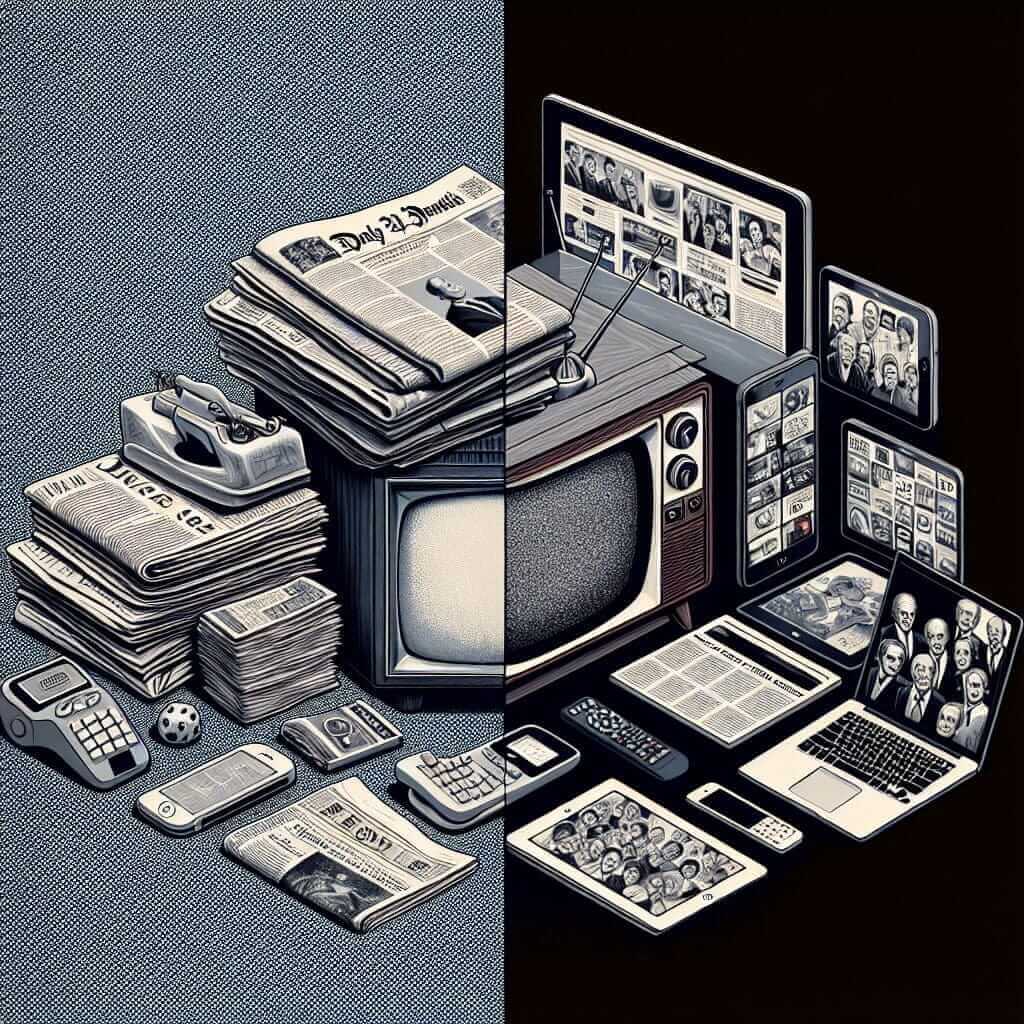The intersection of technology and traditional media is a hot topic in today’s digital age, making it a common theme in IELTS Writing Task 2. This essay will delve into the pervasive influence of technology on traditional media, exploring both its merits and drawbacks. We will analyze a sample IELTS question, provide a band-8 worthy response, and equip you with the vocabulary and grammar tips to conquer this essay topic.
Understanding the Task: IELTS Writing Task 2
Before we dive into the specifics, let’s clarify what IELTS Writing Task 2 entails. You will be presented with an opinion, problem, or discussion point, and asked to write an essay of at least 250 words. Your essay should be well-structured, coherent, and grammatically accurate while demonstrating a wide range of vocabulary.
Sample IELTS Essay Question
Here’s a typical question you might encounter related to the influence of technology on traditional media:
“The advent of technology has revolutionized the way we consume news and information, significantly impacting traditional media outlets like newspapers and television. To what extent do you agree or disagree with this statement?”
Analyzing the Question
This question prompts you to discuss how technology has transformed news consumption and its effects on traditional media. It requires you to:
- Present your stance: Do you agree, disagree, or partially agree with the statement?
- Support your viewpoint: Provide relevant examples and evidence to justify your position.
- Discuss both sides: Acknowledge the opposing view while maintaining your stance.
Model Essay
Technology has undeniably revolutionized how we access information, causing seismic shifts in the landscape of traditional media. While some argue that these changes herald the demise of newspapers and television, I believe that technology, while posing challenges, has also created opportunities for these mediums to adapt and thrive.
On the one hand, the rise of digital platforms has undoubtedly disrupted traditional media. Online news websites and social media provide instant access to a global pool of information, often for free. This immediacy and accessibility have led to a decline in print newspaper subscriptions and television viewership, particularly among younger generations who favor digital formats. Furthermore, the interactive nature of online platforms allows for greater engagement, with users able to comment, share, and participate in discussions, aspects lacking in traditional one-way media.

However, it is too simplistic to declare traditional media obsolete. Newspapers and television channels have adapted to the digital age by establishing their own online presence, offering subscriptions and utilizing social media for wider reach. Moreover, they still hold an edge in terms of credibility and journalistic integrity. Established media houses have built reputations for reliable reporting, fact-checking, and in-depth analysis, aspects often lacking in the unregulated world of online content. This trustworthiness remains a valuable asset in combating the spread of misinformation.
In conclusion, while technology has disrupted traditional media, it has not led to its downfall. Instead, it has spurred innovation and adaptation. As technology continues to evolve, the relationship between traditional and new media will likely become more symbiotic, with each leveraging their strengths to cater to a diverse information-hungry audience. (Word Count: 295 words)
Writing Tips and Analysis
- Structure: The essay follows a clear structure – introduction, body paragraphs (presenting both sides of the argument), and a conclusion.
- Vocabulary: The essay uses a range of sophisticated vocabulary related to the topic, such as “revolutionized,” “seismic shifts,” “immediacy,” “credibility,” and “symbiotic.”
- Grammar and Cohesion: The essay uses complex sentence structures and cohesive devices like “on the one hand,” “however,” and “moreover” to ensure a smooth flow of ideas.
- Supporting Evidence: The essay provides clear examples to support its claims, like the decline in print subscriptions and the rise of online platforms.
Vocabulary Builder
Let’s break down some of the key vocabulary used in the essay:
- Revolutionized (verb): /ˌrɛvəˈluːʃənaɪzd/ – Changed something fundamentally.
- Seismic shifts (noun phrase): /ˈsaɪzmɪk ʃɪfts/ – Significant and fundamental changes.
- Immediacy (noun): /ɪˈmiːdiəsi/ – The quality of being instant or immediate.
- Credibility (noun): /ˌkrɛdəˈbɪləti/ – The quality of being trusted and believed in.
- Symbiotic (adjective): /ˌsɪmbaɪˈɒtɪk/ – Involving a mutually beneficial relationship.
Conclusion
The influence of technology on traditional media is a multifaceted issue with valid arguments on both sides. By structuring your essay effectively, using relevant vocabulary, and providing solid examples, you can achieve a high band score in your IELTS Writing Task 2.
Remember to practice writing essays on similar topics like the impact of social media on news consumption or the role of citizen journalism in the digital age. Familiarizing yourself with these themes and building a strong vocabulary will undoubtedly enhance your writing skills and boost your confidence.
Good luck!